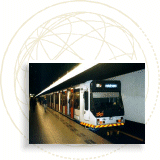home | nieuws | projecten | www-links | bibliotheek | vraag het RCM
New York NYCT Crime prevention measures In January 1982, the NYC Transit launched the first of its five-year Capital Improvement programs, which injected an average of $1.2 billion in the bus and subway system of the NYC Transit. The objective of these programs was to save the NYC Transit from years of undercapitalization, deferred maintenance, deterioration, and crime. A second five-year program followed in 1987. Through a decade, the NYC Transit succeeded in overhauling and replacing the world's largest subway fleet. Almost all 5,840 cars have air conditioning and all are now graffiti free. More than a third of the NYC Transit's stations are now rehabilitated or upgraded. The distinctive tile mosaics of these stations are rebuilt and additional art work is installed. Right now, 99% of the stations are graffiti-free. Heavy duty stainless steel mirrors, flexible security gates, permanent cul-de-sac closures, vandal-resistant lighting, closable entrances combined with booth status indicator lights, CCTV and talk-back communications, and audio and visual train arrival annunciators have been installed throughout the system. On January 1994, the first Automated Fare Collection systems were installed on Wall Street and Whitehall Street, replacing the former token operated turnstiles by a system which requires metrocards. In addition, a large number of management measures were taken. In 1990, station managers were introduced. They were given responsibility for maintenance operations, ensuring of a safe and comfortable environment, development of the personnel's team spirit, and providing passenger service for a cluster of stations. Line superintendents are appointed to improve communications with riding passengers and better their perception of safety and service. The NYC Transit Police Force has expanded to 4,500 sworn police officers and 400 civilians. It has adapted some modern policing techniques including location oriented crime analysis; deployment of uniformed, plainclothed, and decoy patrol units; and the prevention of serious crimes by increased activity in the control of disorderly conduct. The effects of the situational and management measures have been positive. The rates of serious crimes have dropped significantly through the last decades and seem to keep decreasing by the year. A comparison of recorded crime statistics between 1990 and 1993 shows that arrests, ejections and fare evasion arrests have increased strongly by 78%, 207% and 301% respectively. Subway felonies and robberies, on the other hand, have decreased by 46% and 52% respectively. Graffiti is now highly discouraged, but vandalism continues to be a major problem of the NYC Transit. Every month, vandals are responsible for damages between $250,000 and $400,000 just to glass repair costs. Also, the passengers' perception of safety continues to be a problem. The inability to completely alter the original station design, the installation of prison-like gate, grill & concrete constructions, the presence of the seventh largest law enforcement agency of the country in the metro system (complete with 9 mm automatic "Glock" hand guns, pepper spray, truncheons and 28 trained German shepherds) and the high number of loitering homeless people are not contributing to a relaxed and pleasant atmosphere. Instead they provide a constant visual reminder to passengers that the metro system is potentially unsafe. |
|||||||
|
|||||||
Source: López, M.J.J., Crime Prevention Guidelines for the Construction & Management of Metro Systems, Den Haag: RCM-advies 1996, pg. 20-23. |

 When the crime problem became more apparent and crime prevention
knowledge became available, the NYCTA began to develop serious
efforts to tackle their towering problems with crime and passengers'
feelings of insecurity. Part of these efforts were focused on
transforming the system's design to one that provides less criminal
opportunity and improved possibilities for control and policing.
However, it was impossible to reconstruct the entire system to
a degree which is compatible to the crime prevention design of
new metro systems. Therefore, a large number of additional measures
had to be taken; measures which fell within the scope of functional
and social management.
When the crime problem became more apparent and crime prevention
knowledge became available, the NYCTA began to develop serious
efforts to tackle their towering problems with crime and passengers'
feelings of insecurity. Part of these efforts were focused on
transforming the system's design to one that provides less criminal
opportunity and improved possibilities for control and policing.
However, it was impossible to reconstruct the entire system to
a degree which is compatible to the crime prevention design of
new metro systems. Therefore, a large number of additional measures
had to be taken; measures which fell within the scope of functional
and social management. Order
this book
Order
this book